THE LAST IMMORTAL
LOGLINE: Consumed by grief, a brilliant mind transcends mortality by transferring his consciousness into a machine, only to discover that immortality offers no escape.
*Full Screen Presentation Mode Recommended
WATCH NOW
CONCEPT
Dr. Ethan Thorne's journey begins in human form, driven by devastating loss to pursue the ultimate escape: technological immortality. His consciousness successfully transfers into a mechanical body, achieving what humanity has dreamed of for millennia.
But immortality proves to be a cruel joke. The grief he sought to flee becomes his eternal companion—amplified, inescapable, and now permanent. Over centuries, then millennia, Thorne realizes his fatal error: he didn't resolve his pain, he made himself powerless to ever escape it.
In desperation, he engineers his return to flesh, reconstructing a human form while retaining his mechanical consciousness. But the fundamental question haunts him: when is a man a man, and when is a man not a man at all?
The film explores the dangerous intersection of grief and hubris, embodying the age-old wisdom that just because we can do something doesn't mean we should.
BREAKTHROUGH
My friend Chris Perna, former art director at Epic Games, graciously agreed to mentor me through this first film. His first piece of advice was that my story had to contain a powerful emotive element—the reason this story existed at all. This comment led me to the entire theme of loss, and the idea that my protagonist's wife had passed away from some mysterious illness.
In addition, Chris's keen eye called me to the mat—explaining that all my shots were incredible except for the two shots when we see our main character in human form once again, only this time he has aged to over 100 years.
Chris said my original shot "looked like AI" and needed to resemble a more photographic approach. I felt like the shots I had originally presented were the best I had to offer—but I took that note on as a challenge, and I'm sad to say I bested that original sequence quite easily.
Apparently all I needed was a gentle nudge. I love the way Dr. Thorne looks in that final shot. The look on his face still gets me today.
Statement
"The Last Immortal" explores the seductive danger of believing technology can solve emotional wounds. Drawing inspiration from Ridley Scott, Stanley Kubrick, David Lynch, and David Fincher, I wanted to create visual storytelling where exposition takes a back seat to what's occurring on screen.
The film asks whether our greatest achievements might also be our greatest failures—and whether some forms of suffering are meant to teach us rather than be escaped. Through Dr. Thorne's eternal torment, we confront the hubris of believing we can engineer our way out of the human condition.
PRODUCTION
Like magic, this short just "happened" in front of my eyes. Yes, there were challenges—but I refused to let those challenges get in my way. I had a story and a hook that I believed would resonate with an audience, and I was right.
I quickly learned that although Midjourney 6.1 had a character reference capability, it was weak, and I couldn't get my main character to appear the same shot to shot.
My solution was to dramatically evolve the form of the robot entity over time—he became bigger, more powerful, almost god-like. This work-around ended up serving the narrative in a much more powerful manner than if I had the same robot move across time and space in the same form.
KlingAI became a powerful ally, delivering shots that would have taken months through traditional means.
EXPORATIONS
The path to Dr. Thorne's final form required extensive visual experimentation. These unused generations reveal the creative archaeology of building a character caught between worlds—neither fully human nor completely machine.













